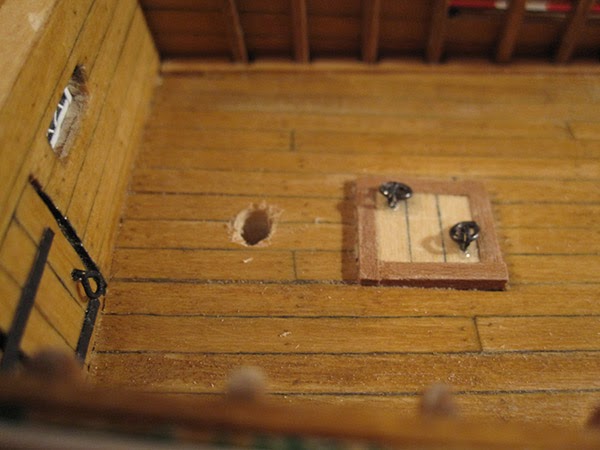There are 3 ladders that needed to be built - 2 from the main deck to the Quarter Deck, and 1 shorter one from the Quarter Deck to the Poop Deck. They all needed to be built from scratch with the provided wood (i.e., they were not laser cut), but the plans came with scaled templates to follow.
The sides of each ladder were made out of a slightly thicker wood, and shaped so they matched the templates. Then, on one side of each side, notches were initially cut out to take the steps:
I then took a file and widened the notches to match the thickness of the wood used for the steps:
I originally cut all of the steps to length, but when the time came to stain them, I went back and used some longer strips which I again cut after they had been stained.
The sides, stained using Plantation Walnut - the steps were simply stained using a Natural stain:
Gluing the pieces together (the top 2 steps would later be trimmed so they would lie flush against the bulkheads). As per the instructions I glued all of the steps into one side first, then after that had dried, attached the other side.

The ladder leading to the Poop Deck - not perfect, but not too bad:

Glued in place:
The ladders to the Quarter Deck, glued in place. The bottom steps turned out pretty good (i.e., straight), but the top ones didn't quite work out (it's much more noticeable in the picture, like all of my mistakes...). I'm still debating whether to go back and try again, or just scratch it up to a lesson learned for next time I do ladders.
Pumps
The next pair of deck details are 2 pumps which go on either side of the main mast (presumably used to pour water on the nearby ropes so they don't get too hot when raising or lowering the sails).
The first step was to take a wooden dowel and file/sand it so it has 8 sides; once done, it was cut into 2 equal lengths (one for each pump):
The brackets and handles:
The spouts and painted eye bolts:
It's hard to see, but the tops of each of the brackets had a narrow slot cut into them, into which will fit the handles. I think I only broke 2 when trying to create those notches...
Everything stained Plantation Walnut, except the main barrels, where I just used a Natural stain. You can also notice the tops of the barrels have their centres slightly carved out (and later painted black) to accept the end of the eye bolts.
Two bands for each of the barrels - they would have been metal on the real pumps, but I used some of the tape left over from the windows which I painted black; the instructions suggested black tape (I didn't have any) or heavy paper.

The pumps completed and in place (and yes, this knight head is supposed to be offset slightly from the mast). You might notice the handle of the left-hand pump is different then the right-hand one. It was quite difficult to get the eye bolt through the hole - I must have broke half a dozen pieces trying to get it to work... So finally I got one that worked and, rather then trying to shape the handle again, I just went with a simpler shape. I probably should have done the same with the other pump so they matched...











































































